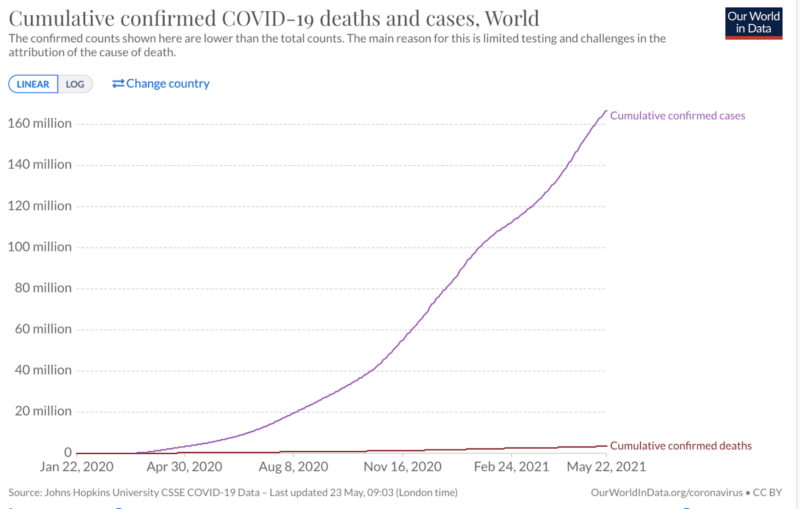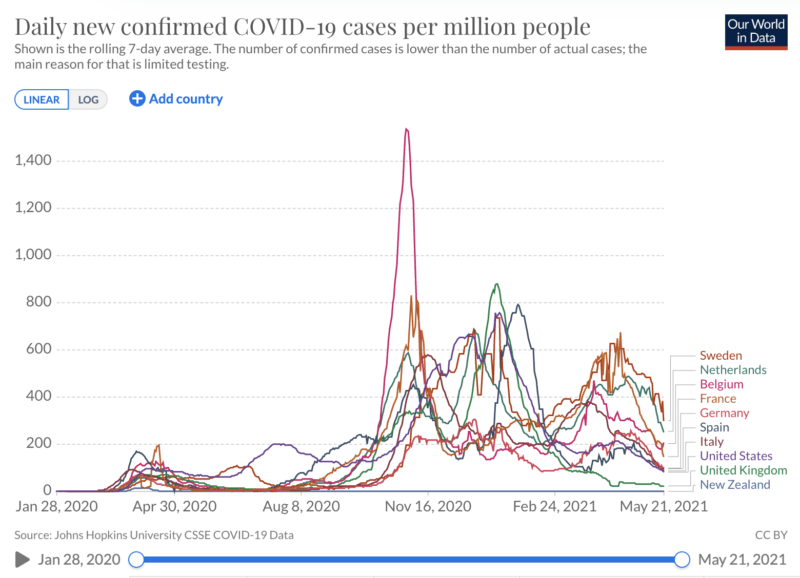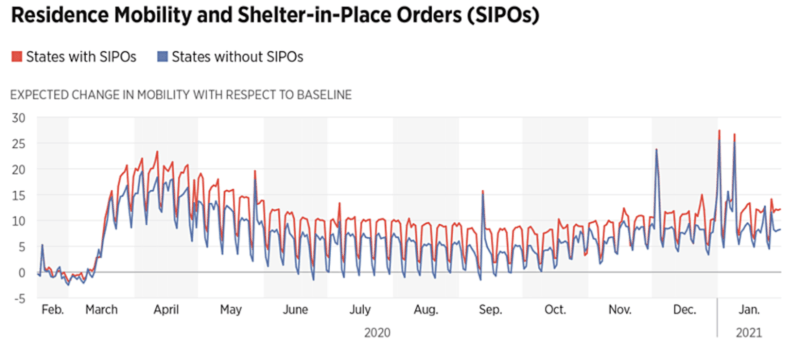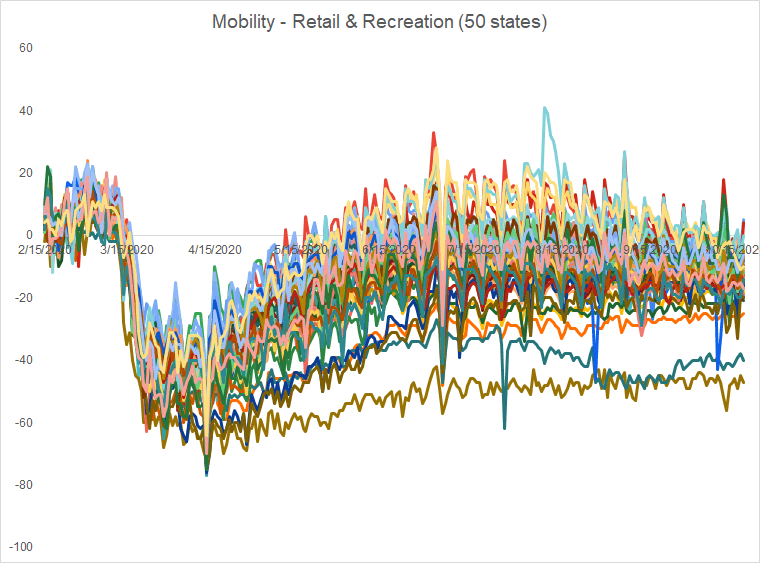Lockdowns Need to Be Intellectually Discredited Once and For All

On May 19, 2021 the LA Times published a column that is representative of the basic arguments for endorsing lockdowns going forward titled “The evidence is clear — COVID lockdowns saved lives without harming economies.”
The column proclaims in large italic font,
“Lockdown should be considered as an effective public health intervention to halt epidemic progression.”
The piece certainly puts forward a case that may be somewhat plausible on its face but after further investigation might be able to pass as scholarly malpractice. The column lays out two major points. The first being that lockdowns played an important role in reducing caseloads. The second point is that the economic damage of lockdowns was relatively inconsequential as the voluntary actions of individuals were largely responsible for the economic downturn.
These are not novel or fringe arguments but talking points that have been parroted throughout the pandemic. The column itself rightly notes that there has and will continue to be a heated debate about the efficacy of lockdown policies for the foreseeable future. Although Covid-19 lockdowns are behind us, the precedent has been set for lockdowns to be a new shiny tool to be used against future pandemics. This horrifying reality is exactly why lockdowns as an idea must not be forgotten. They must be thoroughly discredited, starting with this column.
Do Lockdowns Reduce Caseloads?
It should first be said that reducing deaths is a far more important objective than simply reducing cases, especially when it comes to a highly contagious but relatively mild disease like Covid-19 which only severely affects vulnerable populations. With this in mind, it seems that taking precautions to shield the vulnerable while allowing healthy individuals to live their lives with common sense would be a far better policy. Just look at this graph.

However, let’s bite and say that it’s best that caseloads remain as low as possible if it is within our power to do so.
The column relies on a series of studies that demonstrate a correlation with lockdown policies such as stay-at-home orders and business closures with drops in the daily increase of cases. It asserts,
“It makes sense, therefore to examine the evidence — or rather, gather ammunition for the coming debate.
Numerous studies from across the world have found that lockdowns succeeded in suppressing transmission rates.”
One of the first issues that arise is that studies the column uses to make its point are clearly cherry-picked as they’re not only dozens of studies saying the contrary, but clear methodological shortcomings. The first one is titled “The Efficacy of Lockdown Against COVID-19: A Cross-Country Panel Analysis.” The study asserts that lockdowns were effective in reducing caseloads after running an average of the performance of 202 countries from January 10, 2020, to May 10, 2020. This study was one of the first attempts at piecing together empirical evidence at the very start of the pandemic, which should tell you all you need to know. The study even has a disclaimer that reads,
“For these reasons, we highlight the importance of and need for further investigations on this topic, which may focus on more specific territorial or climatic subsamples, or on how governments have implemented lockdown policies.”
Plugging in hundreds of countries without any regard to context whether it be timing, geographic location, or even the types of policies involved at what would be just the beginning of the pandemic is a quick way to start a conversation, but nothing further. We now know much more.
A similar issue comes up in the second study the author uses to prove his point. The study is titled “Is Lockdown Effective in Limiting SARS-CoV-2 Epidemic Progression?—a Cross-Country Comparative Evaluation Using Epidemiokinetic Tools.” It’s already off on the wrong foot as its timeline runs from February 23, 2020, to June 14, 2020. Furthermore, the study simply notes the initial fall in daily new cases in a number of countries that implemented lockdowns with Sweden and the United States as a comparison as a non-lockdown country and variable lockdown country respectively.
Again no consideration for context when it comes to timing, social behavior, or government policy. Furthermore, as we all know the pandemic and the use of lockdowns didn’t end in the summer of 2020. Here is an expanded timeline with the countries included in the study alongside the addition of Belgium which I added as another example of a European country with strict lockdowns but a poor performance in mitigating Covid-19.

This brings us to the most important point regarding lockdown policies and what seems to be captured in these studies but not properly acknowledged, which is voluntary behavior to reduce the spread of Covid-19. The following data was pulled from a comprehensive analysis published by the Heritage Foundation that examined key statistics compiled throughout the pandemic.

As we can see, regardless of the implementation of stay-at-home orders, people voluntarily reduced their activity. States that implemented stay-at-home orders and other lockdown policies clearly saw greater (and unnecessary) reductions in movement. However the reductions in movement are nearly identical during peak spikes in cases and deaths. In other words, people voluntarily practiced social measures in response to spikes in deaths and cases.
This is congruent with a study published by a team of Stanford researchers that compared 8 lockdown countries with two counterfactuals, South Korea and Sweden. The study found that there are certainly benefits to implementing policy interventions but the benefits of aggressive policies such as lockdowns compared to less intrusive policies undertaken by South Korea and Sweden are minimal. This is without factoring in the collateral damage and the fact that in some contexts, lockdown policies may actually increase caseloads because they force people to gather in private residences, which are often less well-ventilated and more cramped.
This brings us to what is hopefully an emerging consensus that lockdowns, for whatever isolated marginal benefits they provide, are essentially swinging a sledgehammer to kill a spider.
Are Lockdowns Safe for the Economy?
The second major point in the column, that lockdowns are not a major contributor to economic damage, may seem ridiculous at first glance but is actually a relatively common argument. Jack Nicastro and I co-wrote an article for AIER arguing against this assertion in detail here. Our main conclusion was that the past economic downturn was the largest recession in modern history. The one major thing that was different this time was lockdowns, which actively work against economic recovery. We quoted the International Monetary Fund by writing,
“Under the assumption that the pandemic and required containment peaks in the second quarter for most countries in the world, and recedes in the second half of this year, in the April World Economic Outlook we project global growth in 2020 to fall to -3 percent. This is a downgrade of 6.3 percentage points from January 2020, a major revision over a very short period. This makes the Great Lockdown the worst recession since the Great Depression, and far worse than the Global Financial Crisis.”
The main assertion that supports the idea that lockdowns are not responsible for the economic downturn is that voluntary behavior is largely the main causal factor in the recession. If you remember the mobility data I referenced previously to challenge the idea that lockdowns were necessary to contain the spread of Covid-19, you will have remembered that people voluntarily reduced activity.
In order to support its case the column cites a working paper published by NBER titled “Fear, Lockdown, and Diversion: Comparing Drivers of Pandemic Economic Decline 2020.”
The paper notes that people voluntarily reacted to Covid-19 by reducing foot traffic before the lockdowns were implemented and did not increase significantly once lockdowns were lifted. This is congruent with the mobility data I referenced above. This would suggest that lockdowns had a minimal economic effect because people voluntarily stopped patronizing businesses. Of course, a closer look at the data reveals that some non-lockdown states had foot traffic return to normal as the summer came.
The problem with this particular study is of course its timeline, which only measures data from March 1 – May 16. This is when fear and uncertainty about the virus were at an all-time high, which is why voluntary reductions in foot traffic were also high with or without lockdowns. If the timeline is expanded, voluntary behavior and state-mandated behavior begin to diverge, only reaching parity during spikes in deaths and transmission. We can see this divergence after May 16 when many states lifted their stay-at-home orders and saw increases in mobility. During major spikes in transmission and deaths, people voluntarily reduced mobility to parity with states that issued lockdowns. This is most observable during the past Winter season.

To further demonstrate the negative economic consequences of lockdowns, a working paper published by NBER in January of 2021 examines the effect of California’s nonessential business closures on sales data up to Q2 of 2020. The paper notes
“The results suggest that local implementation and enforcement of lockdown restrictions and voluntary behavioral responses as reactions to the perceived local COVID-19 spread both played a role, but enforcement of mandatory restrictions may have had a larger impact on sales losses.”
Furthermore, Covid-19 is a less deadly disease than the 1957-1958 Asian Flu and especially the 1918 Spanish Flu which like all pandemics were handled without lockdowns. The late and great doctor Donald Henderson and colleagues published a paper on the US response to the Asian Flu which notes,
“Despite the large numbers of cases, the 1957 outbreak did not appear to have a significant impact on the U.S. economy.’’
An article published by two economists in VOX-EU, a policy portal of the Centre for Policy Research, notes that during the 1918 Spanish Flu the economy actually grew slightly. This was of course due to World War I and forced labor for the war effort but they ultimately conclude,
“What lessons can we glean from the 1918 pandemic for today? Obviously, we are not advocating for another war, or that workers be encouraged to work in unsafe conditions that may heighten their exposure to the virus. But it is useful to remember that a global pandemic doesn’t inevitably lead to a grave economic recession or depression. More specifically, a large expansion in government demand can go a long way in softening the economic impact of a crisis that clearly threatens to reduce consumption and private investment.”
So perhaps the government can help by providing financial aid to struggling businesses and families to soften the blow of a pandemic. Government after all does know how to cut checks. However, there is absolutely no reason to believe that the government can shut down the entire economy without catastrophic consequences. The Covid-19 pandemic is associated with the worst economic downturn in modern history, worse than the Spanish Flu and the initial stages of the Great Depression. It shouldn’t be that difficult to see that lockdowns were responsible for that.
Key Takeaways
This has essentially been a very long-winded way of saying what AIER has been saying since day one. Lockdowns do not provide any meaningful benefit and they cause unnecessary collateral damage. Voluntary actions and light-handed accommodations to protect the vulnerable according to comprehensive analysis, not cherry-picked studies with overly short timelines, provide similar, if not better, virus mitigation compared to lockdown policies. Furthermore, contrary to what many keep trying to say, it is lockdowns that are the causal factor behind the unprecedented economic and social damage that has been dealt to society. On top of that, we haven’t even addressed the role of inflammatory and counterproductive messaging to sow unnecessary fear into American society. Of course, that’s a topic for another day.
Humans for our entire existence have lived alongside diseases. Society has become increasingly healthier through improvements in living standards and advancements in technology. Unilaterally and arbitrarily shutting down all of economic and social life was never part of the solution, nor should it ever be. Covid-19 has been the first test for these experimental lockdown policies and no rational observer should look back at the results and conclude that this is all worth trying again.










